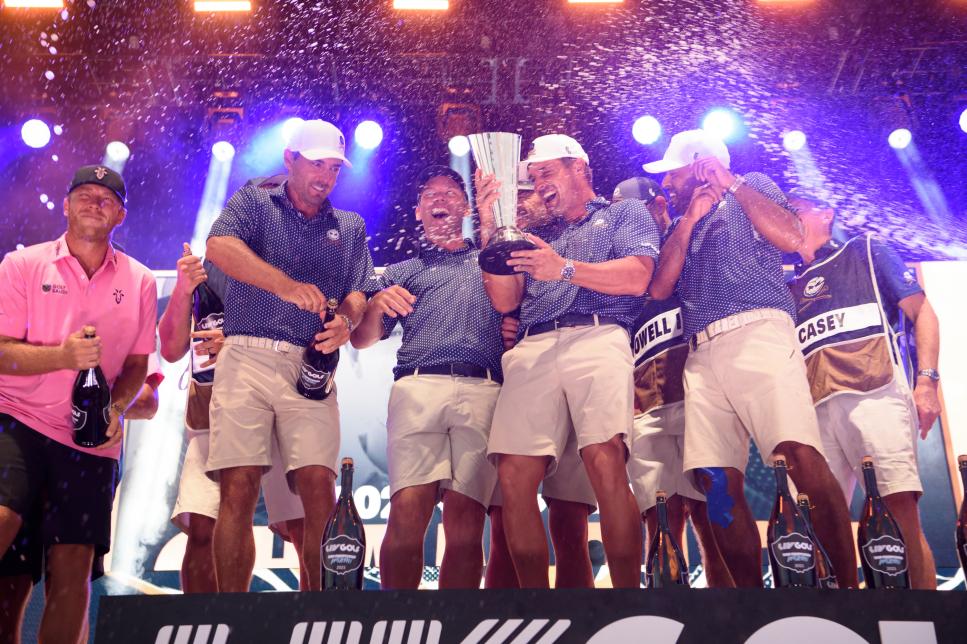[PHOTO: Cliff Hawkins]
As the framework agreement between the PGA Tour and Saudi Arabia’s Public Investment Fund comes closer to fruition—or closer to falling apart, depending on who you ask—LIV Golf wrapped up its season in Miami last weekend. While most of the focus in the sport is where the game is going (and who is behind the wheel), it’s worth taking stock of the league that’s brought the game to a breaking point of sorts. Here is what’s worked and what hasn’t (and what really hasn’t) through two seasons of LIV Golf.
What’s worked: Team drama
One of the most notable stories from LIV this season was Brooks Koepka repeatedly calling out his own teammate, Matthew Wolff. The zealous fan might not have an appetite for such theatrics, but turn on any sports TV, radio or podcast and it’s clear that drama sells. Because it’s an individual sport, professional golf lacks the conflict that is inherent to group anatomies. Rather than try to dampen such inner turmoils, LIV needs to milk them for all their worth.
What hasn’t: Team movement
The NBA has built an entire economy on team transactions. Forget signings and trades and trade requests, roster building and reloading and tearing down; mere rumours and theoretical roster tinkering has assisted the league in becoming an entity consumed year-round. So far, LIV Golf has not tapped into this dynamic, save for one or two players changing teams this past year. If LIV Golf is sticking with its team-centric approach, it needs to allow for more movement between rosters.
What really hasn’t: Relegation
Those around LIV trumpet relegation as a new concept to the sport, save for the fact that every other professional circuit has been doing this for (check’s notes) almost forever. Also, only those finishing 45th or worse in the 48-man league’s individual standings are relegated… and even that comes with an asterisk, as Lee Westwood (45th) and Martin Kaymer (49th) are exempt due to being team captains. Worse, the lack of consequence for bad performance—and as a corollary, the lack of access into competitions—was one of the reasons LIV Golf was denied Official World Golf Ranking points, a decision that has huge repercussions for the league’s future.
Sticking on the team front…
What’s worked: RangeGoats
Game recognise game: the colours, name, and logo are all on point.

What hasn’t: The rest of the teams’ names and logos
Which appear to be lifted from a kindergarten classroom… or in the case of Phil Mickelson’s team, accused of copyright infringement.
What really hasn’t: Team loyalty
All due respect to Bubba Watson’s kid, the team’s have mostly failed to build their own unique identities, to say nothing of fan bases. If the team structure is what separates LIV from its competitors, the league is not doing enough to sell the importance of its point of variance.
What’s worked: TV production
No need to re-litigate the ongoing issues with golf broadcasts in this space. To LIV’s credit, the league puts a premium on showing game action, both in the amount of shots and who is hitting them. The team component is an asset on this front as it allows for more players to be relevant to the competition during the final round versus what a viewer sees coming down the stretch of a PGA Tour event. There’s also not much of a commercial load, which, admittedly, could be chalked up to the hesitancy of being associated with the LIV brand. Yet, against the backdrop of the golf consumer being inundated with ads over action, it’s worth noting.
What hasn’t: TV announcing
Golf TV commentary can often come across as cheerleading and has never been confused with hard-hitting journalism. But holy cow, the LIV broadcasters are such naked propagandists it begs the question if it’s parody.
What really hasn’t: Flash mobs
Professional golf can be a stale product, and many in the game wish the decision makers would take more creative chances. So knocking LIV for swinging for the fence is a bit hypocritical. Conversely, it’s 2023, not 2003, and swinging for the fence with a flash mob is like going in to bat against Mitchell Starc with a swimming pool noodle. (Although, in LIV’s defence, a good chunk of its roster was last relevant in 2003.)
What’s worked: No competitive degeneration
One of the primary concerns in 2022 to those who defected to LIV was its exhibition-like confines could lead to competitive atrophy. However, Brooks Koepka contended at the Masters and won the PGA Championship, and a number of other LIV members had legitimate showings at major championships. There’s even the case that LIV’s schedule allows for its players to be fresh for golf’s biggest events.
What hasn’t: Competitive week-to-week atmospheres
It seems too easy to say because it’s been a common criticism of LIV, yet it rings true: the week-to-week product continues to feel like an exhibition, not a true competition. A not-so-insignificant part of that is LIV’s roster construction. Aside from half a dozen in-their-prime stars (more on this in a moment), it’s still a league composed mostly of injury-prone players or players over the hill or players who’ve never seen a hill, fullstop. How fans are supposed to evaluate what a performance means against that competition remains unclear.
What really hasn’t: LIV’s competitive future
Both the Masters and Open rejected a report that their respective tournaments are considering exemptions for LIV Golf members. It’s also worth noting that representatives from the governing bodies (including Augusta National and the R&A) were on the OWGR board that denied LIV Golf’s world ranking application. While we’re here, LIV Golf spurred an antitrust claim that entangled many of those same individuals and bodies in a US Department of Justice probe, so it stands to reason the powers that be are in no rush to do LIV Golf a solid. In short, any future players that decide to jump to LIV Golf—particularly those with no future guarantee of major-championship field spots—are signalling they are more interested in a payday than true competition. Which is fine; it’s just they are no longer gladiators, but barnstormers.
What’s worked: Australia
Australia is a golf-starved nation that the PGA Tour has long ignored, save for the occasional Presidents Cup. Arguably LIV Golf’s biggest victory in 2023 was its visit to Adelaide, which had a spirited and well-attended showing. It was one of the few times that LIV Golf’s bite lived up to its bark and showed a glimpse of everything it could be.
OPINION: If the PGA Tour wants to save its foothold in Australia, it had better move fast
What hasn’t: American venues
The courses themselves are uninspired designs and the crowds came nowhere close to matching Australia’s fervour. And Boston, one of the few sites that attracted a spirited gathering in its inaugural season, was eliminated from this past year’s schedule.
What really hasn’t: Flash mobs
Sorry, but we had to list it twice. Please never do this again.

What’s worked: Bryson DeChambeau
Between LIV’s failure to resonate with the public and 18 months of injured and uninspiring play, the paradigm shifter had become somewhat of an afterthought. Which, frankly, was a bummer. DeChambeau may be, ahem, a divisive figure, yet he is never vanilla, and golf is better with some colour. Whatever criticisms aimed at those joining LIV, DeChambeau has not channelled the exuberant riches into early retirement, changing coaches and retooling his swing to return to the results he knows he can still achieve. DeChambeau made a run at the PGA Championship, won two individual LIV events this year (including one punctuated with a final-round 58) and secured the team championship at the team finale. There are just a handful of golfers that have the capacity to capture the casual fan’s attention, and DeChambeau is on of ‘em.
What hasn’t: Almost every other big signing
Re-read the last sentence from the above paragraph. Dustin Johnson, Cam Smith, Koepka… there’s no doubt these players gave LIV Golf some legitimacy when jumping ship. But after the shock of their initial defections, they have mostly faded into the background with regard to their play on LIV. Not helping is Koepka, who has tried to distance himself from LIV at majors and the Ryder Cup, letting it be known that while he is with them, he is not one of them.
What really hasn’t: Old guys
Save for a weekend run by Phil Mickelson at the Masters, there has been no new lease on life with their games. Professional golf remains a game powered and dominated by youth, and fans seem to recognise that many of the 40-plus crowd were merely jumping at golden parachutes.
What’s worked: Fan-first focus
An argument could be made that LIV does a better job of catering to the in-person consumer experience than any professional golf circuit. The fan villages trump anything regularly seen on the PGA or DP World tours. Food and ticket prices are affordable. Autographs are easier to get than at a PGA Tour event, and the music that plays constantly in the background—while not for everybody—is surprisingly enjoyable. It is a friendly environment in an era when the common fan is being pushed to the periphery by major sporting leagues.
What hasn’t worked: The bluster
Listen, no one likes to get thrown out of their favourite bar. But that doesn’t mean every time you need to talk about your new bar you need to throw your old one under the bus, you know? Or worse, attempt to sue the old one out of existence.
What really hasn’t worked: The predictions
We could pick any number of failed forecasts, although the one that encapsulates the point is the time last year when Greg Norman said LIV was targeting seven top-20 players to add to its roster. The players LIV ultimately added: Thomas Pieters, Mito Pereira, Dean Burmester, Sebastian Munoz, Brendan Steele and Danny Lee. If LIV truly wants to be taken seriously it needs to stop scoring goals on itself.

What’s worked: Matchplay championship
Matchplay continues to be an under-utilised asset by professional golf, and it’s no coincidence that perhaps LIV’s most compelling presentation all year was its matchplay finale at Doral.
What hasn’t: Lack of matchplay in the regular season
Professional golf is already saturated with individual, 72-hole strokeplay formats. That LIV continues to mirror what is done everywhere else is a big miss.
What really hasn’t worked: The dual individual and team competitions
Not only is it confusing, it’s one of the reasons that prevented LIV from earning OWGR points.
What’s worked: Waiting out moral hand-wringing
LIV Golf is funded by a government accused of human-rights atrocities. There is still no escaping that reality, as much as LIV and its members try. However, whatever ethical high ground held by the PGA Tour has been lost, as the tour has attempted to partner with the very thing they stood against on principle.
What hasn’t worked: LIV as a threat
Yes, LIV Golf can still Scrooge McDuck mountains of gold. More players may jump. But LIV lost its most formidable weapons against the PGA Tour in the lawsuit and the OWGR battle. It doesn’t mean LIV has lost the war, and the war will definitely continue (which, for the rest of golf, seems like a loss), but a path for victory may no longer exist for LIV.
What really hasn’t: Traction
While its players’ acidic quotes routinely make headlines, what happens during their competitions does not. Every respectable metric has underlined that LIV Golf has failed to gain an audience, to the point where the league stopped reporting its own numbers. If the framework agreement does not come to fruition it’s hard to see any more in-their-prime stars jumping towards LIV (especially after none did prior to this season). Its financial backing confers LIV Golf a forever runway to take flight. Problem is, after two years and billions of dollars, no one wants to get on board.




